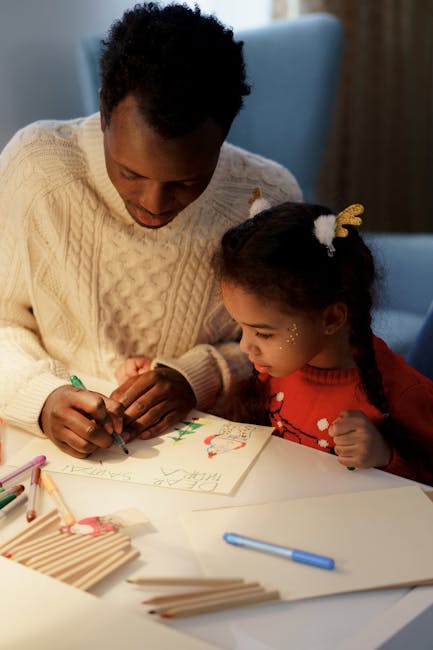Effective Methods for Instilling Home Responsibility

Are you tired of feeling like a maid in your own home? Do you dream of a day when your family members actually take initiative to help out with household chores? Well, fear not, because we have the ultimate guide to turning your lazy roommates into responsible adults. Get ready to say goodbye to dishes piling up in the sink and laundry taking over your living room, because we’re about to unleash some seriously effective methods for instilling home responsibility. Trust us, your sanity will thank you.
Identifying Age-Appropriate Chores for Children
So you’re finally ready to put those little rugrats to work, huh? Here’s a rundown of some age-appropriate chores for your mini-me’s!
For the littlest ones, start with simple tasks that won’t make them chip a nail (or stub a toe).
- Dusting: Give them a feather duster and let them loose on the bookshelves.
- Picking up toys: Time to teach them that toys don’t magically float back to their toy chest!
Once they hit the tween years, it’s time to step it up a notch – they can handle a bit more responsibility (or so you hope).
- Making their bed: It’s about time they learn how to tame those wild sheets!
- Taking out the trash: As long as they don’t try to stuff their little brother in there…
By the time they hit the teenage years, they should be ready for more challenging chores (but let’s not hold our breath).
- Cleaning the bathroom: Just make sure they actually use soap this time.
- Doing their own laundry: They may come out looking mismatched, but at least they’re learning!

Creating a Chore Chart or Schedule
Who doesn’t love chores, am I right? Okay, maybe not, but hey, they’re a necessary evil to keep things running smoothly in your household. And what better way to organize those dreaded tasks than with a chore chart or schedule?
First things first, round up all your housemates and gather ‘round to discuss the chore situation. Make sure everyone’s on the same page and ready to pitch in (or at least pretend to be). To keep things fair, you can divvy up chores based on everyone’s preferences – because who doesn’t love scrubbing toilets or taking out the trash, am I right?
Next, it’s time to get crafty and create your very own chore chart. Get out the markers, stickers, and glitter glue if you’re feeling fancy. Make sure to hang it up in a visible spot so no one can make any excuses about “forgetting” their responsibilities. And hey, why not add a little motivational quote like “Cleaning is just adulting with a spray bottle” to really get everyone in the spirit?
Remember, consistency is key when it comes to sticking to your chore chart. Don’t let anyone weasel out of their assigned duties – unless they want to face the wrath of a glitter glue-covered chore wheel. Trust me, you don’t want to mess with the chore chart enforcer (I’ve heard they’re ruthless).

consequences“>Setting Clear Expectations and Consequences
When it comes to setting expectations and consequences, it’s important to be as clear as crystal clear. Like, clearer than a freshly Windexed window on a sunny day. If you’re wishy-washy or vague, well, you might as well be speaking in riddles to a group of confused lemurs.
One way to ensure everyone knows what’s expected of them is to create a *bold* list of rules. Make it snazzy, make it pop! Throw in some sparkles and glitter if you have to (figuratively, of course). And don’t forget, consequences are just as important as expectations. Think of them as the yin to your yang, the peanut butter to your jelly, the Tony Stark to your Iron Man.
Now, when it comes to consequences, think outside the box (but not too far outside, we don’t want to end up in a parallel universe). Get creative! Maybe the consequence for showing up late to a meeting is having to wear a silly hat for the rest of the day. Or maybe the consequence for not meeting a deadline is having to sing karaoke in front of the entire office. The possibilities are endless!
Remember, doesn’t have to be a drag. It can be fun, it can be engaging, it can be a chance to show off your creative genius. So go ahead, get those rules in order, lay down the law (but in a fun way), and watch as your team thrives under your crystal-clear guidance.

Implementing a Rewards System
So you’ve decided to take the plunge and implement a rewards system in your organization. Congratulations! Buckle your seatbelts, because things are about to get a whole lot more exciting around here.
First things first, let’s talk about what rewards you’re going to offer. Will it be a simple pat on the back, a gift card to the local coffee shop, or maybe even a golden crown fit for a king or queen? The possibilities are endless, so get creative!
Next up, you’ll need to establish some ground rules. Who is eligible for rewards? How often will they be given out? And most importantly, how will you prevent any jealousy or sabotage amongst your employees? It’s like Survivor, but with a lot less bug-eating.
Remember, the key to a successful rewards system is consistency and fairness. Make sure everyone knows what they need to do in order to earn those coveted prizes. And hey, if all else fails, just remember: there’s always the option of a good old-fashioned dance-off to determine the winner. Shake it like a polaroid picture, folks!

Modeling Responsibility in the Home
As parents, it’s important for us to set a good example for our children when it comes to taking responsibility in the home. Here are some tips on how to model responsibility in a fun and engaging way:
1. **Lead by Example: Make sure to demonstrate responsible behaviors around the house, such as cleaning up after yourself, doing chores without being asked, and following through on commitments.
2. **Get the Kids Involved: Encourage your children to take on tasks around the house and hold them accountable for completing them. This could be anything from setting the table for dinner to helping with laundry.
3. **Create a Chore Chart: Make a colorful and interactive chore chart that outlines which tasks need to be done each day. This can be a fun way to teach kids about responsibility and teamwork.
4. **Set Realistic Expectations: Make sure to set realistic expectations for your children based on their age and abilities. Remember, it’s okay to give gentle reminders and praise their efforts along the way.
independence-and-accountability“>Encouraging Independence and Accountability
So, you want your kids to learn how to fend for themselves, huh? Well, I’ve got some tips that will have them cooking up a storm and doing their own laundry in no time!
First things first, let’s talk about chores. **Creating a chore chart** is a great way to encourage independence and accountability. Make sure to assign age-appropriate tasks like folding laundry, emptying the dishwasher, or cleaning the bathroom. And hey, if they shirk their responsibilities, maybe it’s time to introduce a little thing called consequences – like no Wi-Fi for a week. That’ll get ‘em moving!
Next up, let’s tackle mealtime. **Teach your kids basic cooking skills** and watch them whip up gourmet grilled cheese sandwiches in no time. Encourage them to plan and prepare their meals, and who knows, maybe you’ll be kicking back with a margarita while they take care of dinner.
Lastly, don’t forget about money matters. **Give your kids some financial responsibilities** – like managing their allowance or saving up for that new video game. It’s never too early to learn the value of a dollar… or see the consequences of blowing all your cash on candy.
FAQs
How can I get my kids to help out around the house without constant nagging?
Just tell them that if they don’t start doing their share of the chores, you’ll be forced to implement a new rule – for every sock left lying around, they lose a minute of screen time. Watch how quickly they start picking up after themselves!
What are some creative ways to make household tasks more fun for my kids?
Turn laundry folding into a race against the clock, see who can make their bed the fastest, or create a chore chart with silly rewards like ”Dance Party in the Living Room” or “Extra Dessert Night.”
My kids always complain about having too much homework to help with chores. How can I balance responsibilities?
Remind them that they’re not the only ones with tasks to do, and that pitching in around the house is just as important as finishing that math worksheet. Plus, who needs to study when you can learn valuable life skills like how to properly scrub a toilet?
What do I do if my kids still refuse to take on any household responsibilities?
Consider implementing a ”Fine System” – every time a chore is neglected, they owe you a quarter. Soon enough, they’ll be begging for the chance to clean the kitchen just to earn some cash back.
How can I model good behavior and responsibility for my kids?
Lead by example! Make a show of joyfully scrubbing the floors or gleefully taking out the trash. Your enthusiasm will be infectious, and soon enough, your kids will be fighting over who gets to do the dishes.
So remember, home responsibility doesn’t have to be a daunting task!
With a little creativity and a lot of patience, you can turn chores into a fun and educational experience for the whole family. Whether it’s creating a chore chart, rewarding good behavior, or simply leading by example, there are plenty of effective methods for instilling home responsibility in kids of all ages. So roll up your sleeves, grab a mop, and get ready to transform your home into a well-oiled, chore-doing machine!






